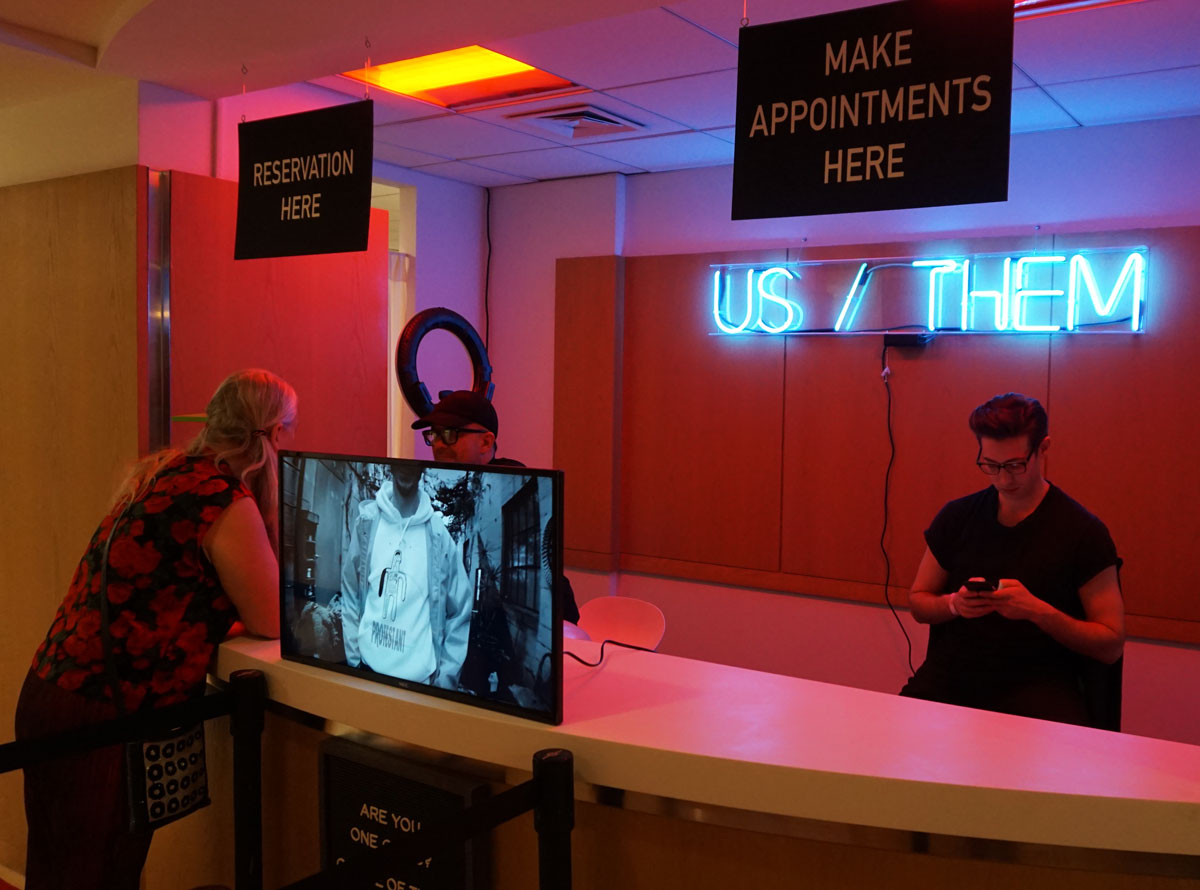[ad_1]
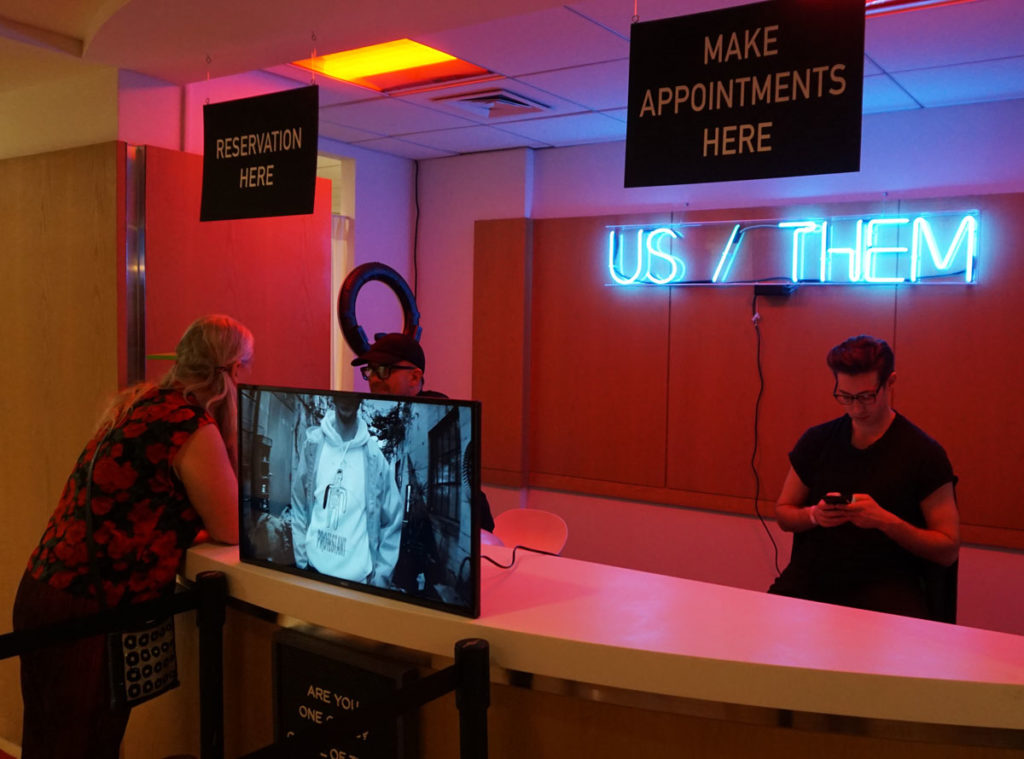
Performance view of Jonathan Paul’s US/THEM, 2018, at Spring/Break Art Show 2019.
KATHERINE MCMAHON/ARTNEWS
The Spring/Break Art Show, a curatorially driven fair that has taken over unconventional locations in New York since its founding in 2009, opened Armory Week on Tuesday morning with an incarnation in a new home: 866 UN Plaza, a building filled with commercial “office condominium” space near the United Nations and across from Trump World Tower. After previous editions staged in a former school, a post office, and old offices of the media company Condé Nast, the new site in Midtown Manhattan makes for a tighter affair than usual, with some 94 presenters in a format that has by and large eschewed Spring/Break’s formerly chaotic and riotous ethos. This year, more than 75 percent of the exhibitors are presented in the open-plan style that dominates most art fairs, even if the theme is unusual: “Fact and Fiction.”
With its emphasis on very contemporary work—including questionable paintings and overly literal interpretations of the theme—Spring/Break, which runs through March 11, has taken on some of the vibes of the NADA Art Fair, which canceled its New York edition for this year. It has even attracted curatorial endeavors from some A-list names, including fashion design Betsy Johnson, artists Dustin Yellin and Andres Serrano, writer Carlo McCormick, and gallerist Magda Sawon. It seems safe to say that Spring/Break has grown up.
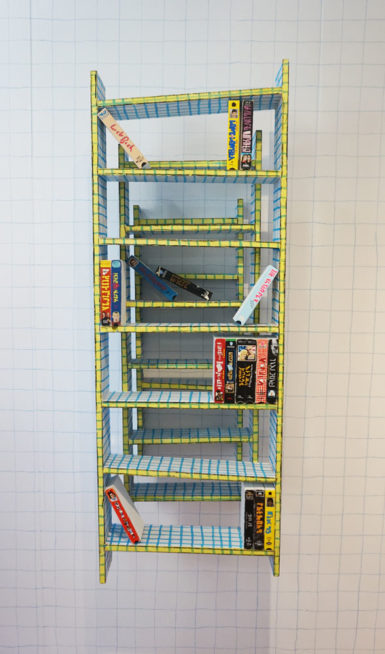
View of “Eliot Greenwald: Tell Me Again,” curated by Courtney Childress, at the 2019 Spring/Break Art Show.
KATHERINE MCMAHON
As with any fair, a large swath of the work on offer at Spring/Break won’t make it into the history books, though some of it drew prominent buyers including ARTnews “Top 200 Collector” Beth Rudin DeWoody, who was on hand at today’s VIP preview and with an eye for acquisition. One work she snapped up within the first hour of the fair was a shelf of VHS tape facsimiles by Eliot Greenwald, in an installation curated by Courtney Childress under the title “Tell Me Again.” For the series, Greenwald created slightly abstracted versions of tapes in his personal collection. In one, he presents 16 different tapes on one shelf, and he mentioned that they could be rearranged into countless permutations without repeating—more combinations than there are “visible stars,” he said.
The New York-based nonprofit Howl Arts has two exhibitions at the fair. One showcases vibrant masks and props crafted by the East Village playwright, actor, and comedian Tom Murrin, who was active in the 1970s and later earned the moniker “Godfather of Performance Art” from the organization Performance Space 122. Though Howl acquired the objects on hand—which Murrin forged from found materials and garbage—years ago, the nonprofit has not previously exhibited them.
Howl is also showing painted ceramics and mixed media works nearby by Scooter LaForge, who has a show of new work at Howl’s gallery space in the East Village. The colorful and meticulously arranged amphorae in “Mount Vesuvius Fire Sale” were inspired by a trip to Pompeii, where the artist saw pieces excavated from archeological sites. An octopus, human bodies, and upside-down heads decorate some of the vases on view.
“When they started excavating at Pompeii, they found this very promiscuous imagery,” Ted Riederer, the artistic director of Howl, told ARTnews. “There were penises on every street corner. There were something like over 20 brothels in a city of 5,000 people.” He added that LaForge’s use of ash clouds as a motif in the work represents both the erupting volcano and a “specter of some kind of social anxiety.”
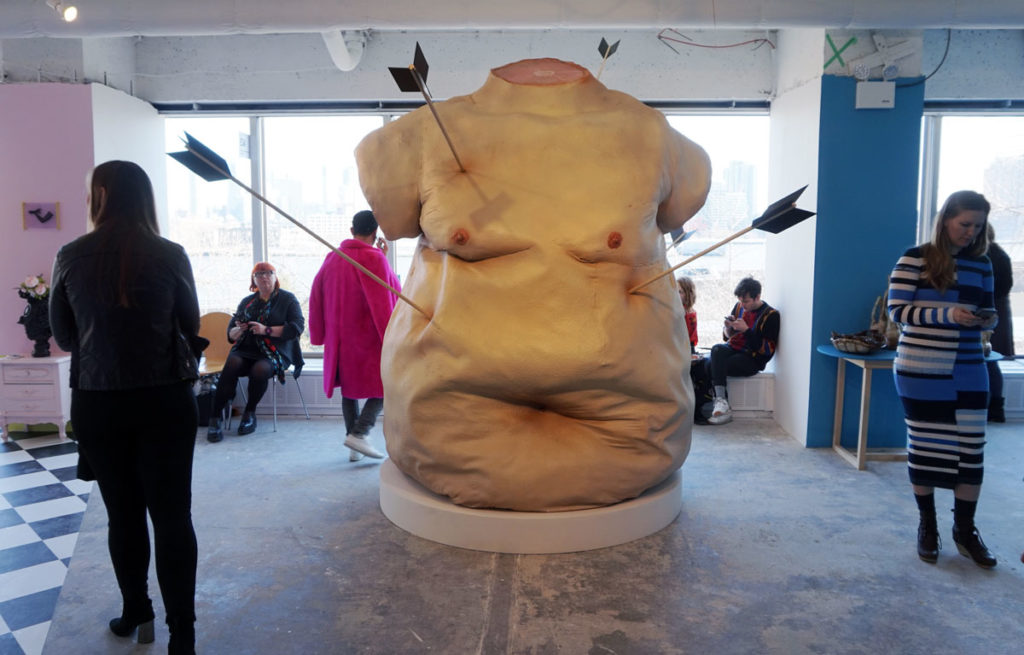
Jen Catron and Paul Outlaw’s Tipping Point, 2018, curated by Magda Sawon, at Spring/Break Art Show 2019.
KATHERINE MCMAHON/ARTNEWS
Magda Sawon’s entry for Spring/Break is Jen Catron and Paul Outlaw’s massive sculpture Tipping Point (2018), which shows a dismembered torso that is punctured with arrows, à la Saint Sebastian. The back of the rotund form, evocative of President Trump, contains a fridge with miniature versions of the sculpture in marzipan.
A solo outing by Alison Jackson elsewhere in the fair also takes up Trump in staged photographs that use body doubles of politicians and celebrities to create fictional compositions. In one, Trump is arm-in-arm with four hooded members of the Ku Klux Klan in front of a burning cross. Another has him reaching for a bucket of chicken from KFC while in the company of Queen Elizabeth II. Others show presidents of old: Obama out for a smoke break and a naked Bill Clinton getting a massage from a young woman as he watches Hillary on TV.
Paintings by Chris Cohen respond to the tumult of our current age in a booth curated by John Ros. For a series of works, Cohen mined family photos to paint images from his childhood—though with his face and that of his father covered with white masks. While growing up, the artist believed his family was left of center, but in recent years he realized his father is not as liberal as he believed him to be. (His father has since broken off their relationship.) Cohen said he wanted to look at his “conflicted relationship with identity and whiteness.” He wondered aloud, “How permanent is it? Is it something we must accept and inherit, or is removable like a mask?”
For a special project titled “US/THEM,” Jonathan Paul has also taken up the ways in which we might navigate identity. The work, which debuted at Art Miami last year, places the artist with an assistant in seats behind a booth. Those who make reservations can talk with Paul, while those looking to make an appointment talk to the assistant. Taking inspiration from Terry Gilliam’s 1985 Brazil—in which characters make “decisions based on a stupid, silly machine,” the artist said—he has created his own machine of sorts to determine if participants are “one of us or one of them.” In reference to talk of borders and walls, gun control, sexual identity, the #metoo movement, and more, Paul said, “I feel very polarized these days. Your identity [and] things you feel strongly about were given to you randomly at birth.”
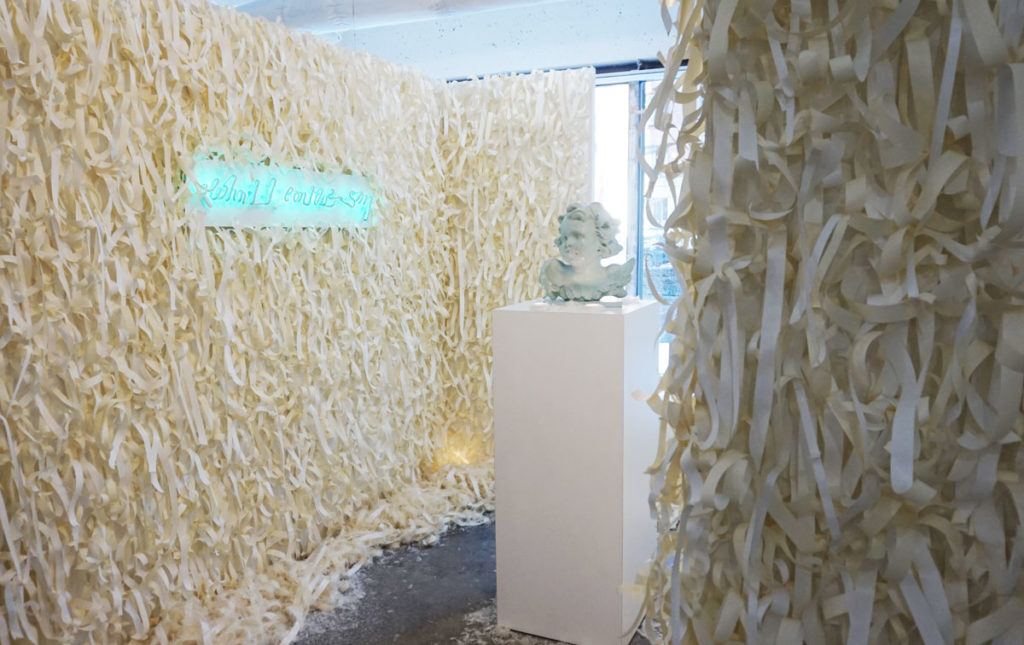
Rachel Lee Hovnanian’s “Taped Shut,” 2019, curated by Jenny Mushkin Goldman and Jessica Davidson, at Spring/Break Art Show 2019.
KATHERINE MCMAHON/ARTNEWS
Two other works in the fair engage the #metoo movement head-on, to varying affect. “No More Lip Service,” a project by Karen Mainenti and curated by Marly Hammer and Lisa Wirth, presents a “#metoo boutique” replete with a vanity and lipstick. Another, Rachel Lee Hovnanian’s installation “Taped Shut,” features hundreds of strips of masking tape on walls surrounding two neon works that read “what I couldn’t say” and “what I didn’t say.” On the floor the artist had placed plumage from birds—a nod to the adage that victims, particularly women, shouldn’t ruffle feathers. Visitors are asked to tape their mouths shut in solidarity “for those who can’t speak their truth,” said co-curator Jenny Mushkin Goldman (who organized the project with Jessica Davidson).
In the booth for the Harlem-based Ki Smith Gallery, Ryan Bock is presenting paintings and interactive sculptural works under the title “See Something, Say Something,” a reference to the oft-heard catchphrase that broadcasts across the New York City subway system. The artist said that the show is “playing off the absurdity of the slogan itself.”
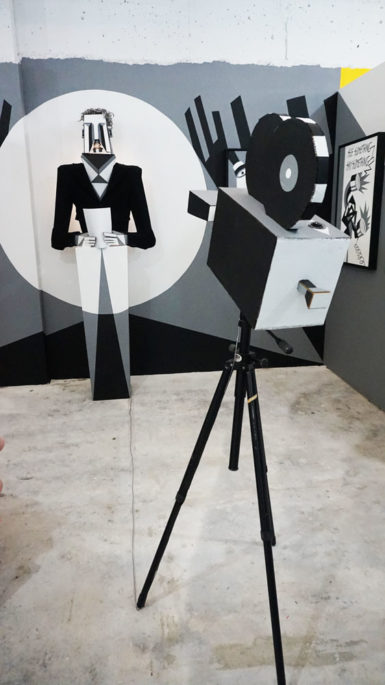
Installation view of Ryan Bock’s “See Something, Say Something,” curated by Ki Smith Gallery, at Spring/Break Art Show 2019.
KATHERINE MCMAHON/ARTNEWS
Bock’s propaganda-style paintings, with dynamic diagonals and depictions of watchful eyes, surround an eerie bust of a news anchor with a video camera made from cardboard. A wig fashioned from the artist’s own hair sits atop the anchor’s head, and a button on the camera will set the figure’s mouth full of fake teeth into motion.
“To me, ‘See something, say something’ is basically the government incentivizing us to tell on people,” Bock said. “This is essentially a way to broadcast a message.”
The hyper-realist illustrator Cj Hendry is presenting Drug Money, an interactive piece inspired by America’s legal and illegal drug trades and those who profit from it. Curated by John Zinonos, the work invites visitors to climb into a monumental pill bottle and attempt to catch as much paper money as possible. The hand-drawn bills of varying amounts are projected into the air by a fan at the base of the tubular structure.
Situated behind a black curtain is Aysha Hamouda’s aptly named Each body—A Vertiginous House, a site-specific installation comprising geometric formations made of taut string and illuminated by black lights. Viewers are invited to climb around in and around the shapes to witness the ways in which the work changes based on their position relative to it. Moving around the seemingly glowing work, which stretches across a dark room, jumbles one’s sense of depth and equilibrium. The work looks at the ways in which “perception can be weaponized,” Courtney Asztalos, who curated the project, said.
Another highlight of the fair, Jack and Leigh Ruby’s “. . .And All the Reported Laughed and Took Pictures” (curated by Snark.Art) looks at the ways in which language and the truth can be weaponized too. For the performative piece, actors approach passersby and begin speaking unprompted. There are four at any time, and sometimes one will begin speaking as others chime in, all speaking the same words—sentiments like “Some people just aren’t ready, they may never be” or “I own every mistake.”
Slowly, it becomes clear that they are reciting statements by people who have an “economical” interpretation of truth, as Simon Lee, one of the performers, put it. (Some of these include the former New York Times editor and alleged plagiarist Jill Abramson and Chris Christie, the past New Jersey governor who got embroiled in a scandal involving M&Ms.) For those who spend time to engage with the piece—rather than just laugh, snap a picture, and more on—it is a rewarding intervention that harkens back to the best that Spring/Break is known for showcasing.
[ad_2]
Source link

